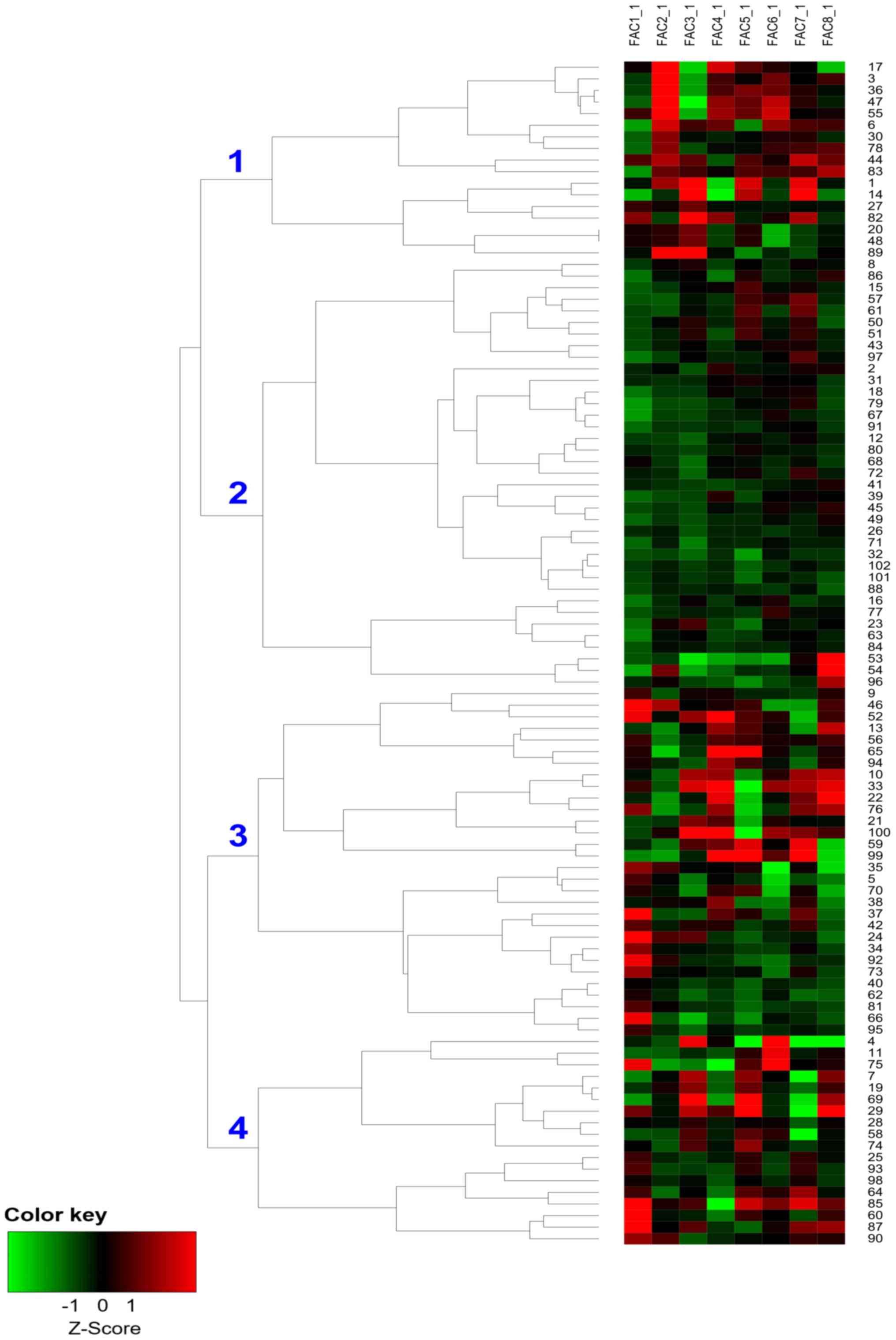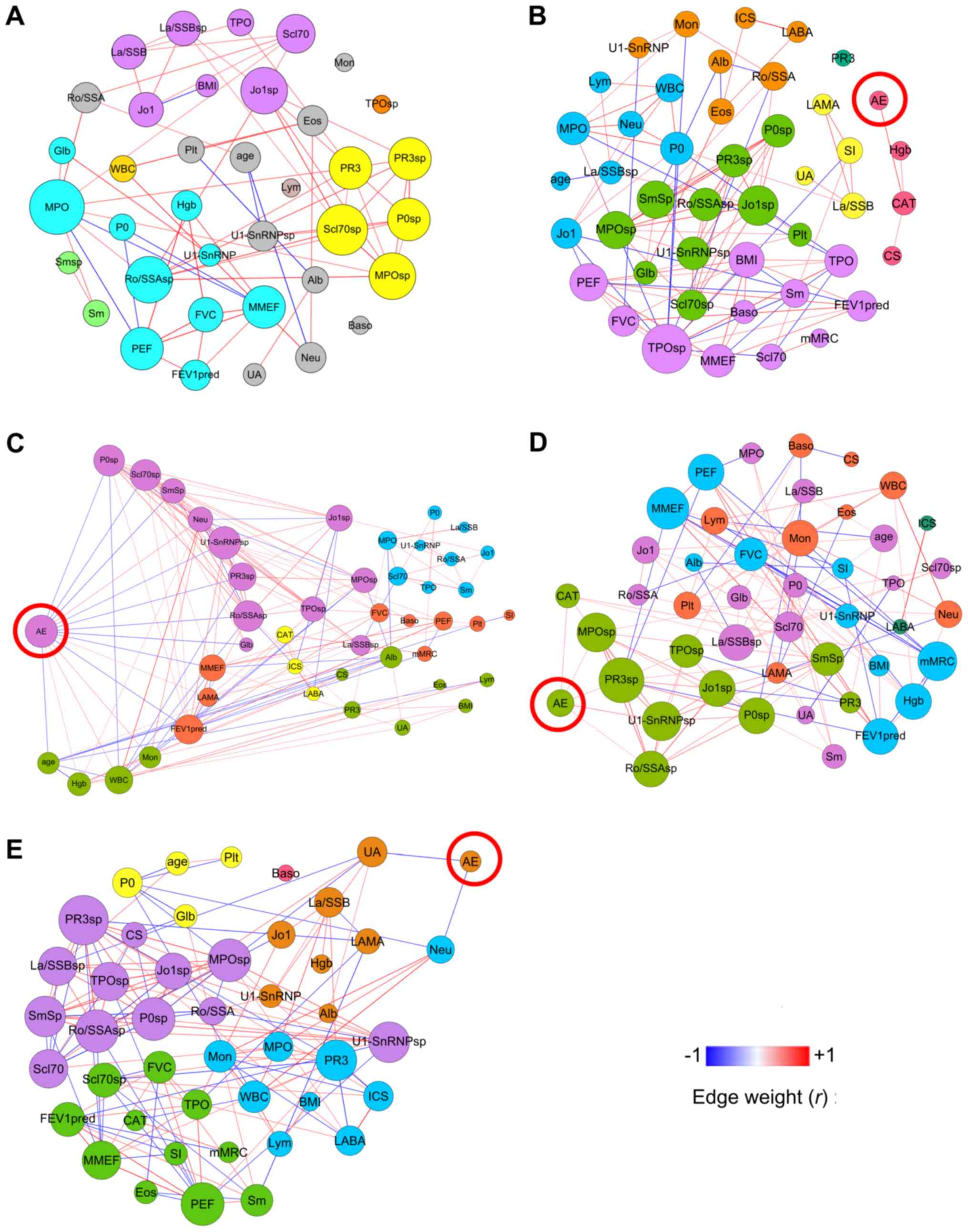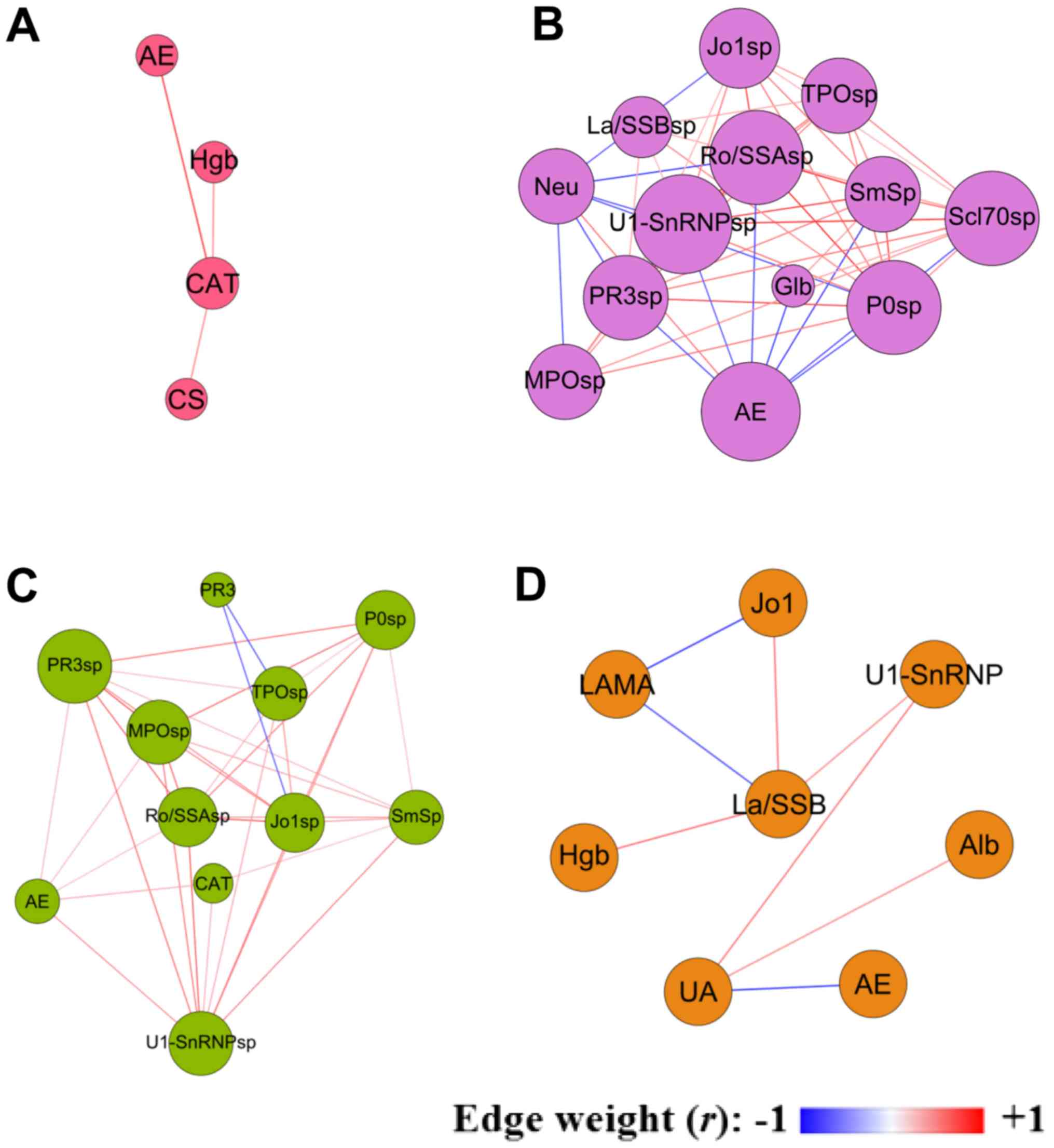|
1
|
Vogelmeier CF, Criner GJ, Martinez FJ,
Anzueto A, Barnes PJ, Bourbeau J, Celli BR, Chen R, Decramer M,
Fabbri LM, et al: Global strategy for the diagnosis, management and
prevention of chronic obstructive lung disease 2017 report. GOLD
executive summary. Am J Respir Crit Care Med. 195:557–582. 2017.
View Article : Google Scholar : PubMed/NCBI
|
|
2
|
Agusti A, Celli B and Faner R: What does
endotyping mean for treatment in chronic obstructive pulmonary
disease? Lancet. 390:980–987. 2017. View Article : Google Scholar : PubMed/NCBI
|
|
3
|
Lopez-Campos JL and Agusti A:
Heterogeneity of chronic obstructive pulmonary disease
exacerbations: A two-axes classification proposal. Lancet Respir
Med. 3:729–734. 2015. View Article : Google Scholar : PubMed/NCBI
|
|
4
|
Agusti A, MacNee W, Donaldson K and Cosio
M: Hypothesis: Does COPD have an autoimmune component? Thorax.
58:832–834. 2003. View Article : Google Scholar : PubMed/NCBI
|
|
5
|
Brusselle GG, Joos GF and Bracke KR: New
insights into the immunology of chronic obstructive pulmonary
disease. Lancet. 378:1015–1026. 2011. View Article : Google Scholar : PubMed/NCBI
|
|
6
|
Polverino F, Seys LJ, Bracke KR and Owen
CA: B cells in chronic obstructive pulmonary disease: Moving to
center stage. Am J Physiol Lung Cell Mol Physiol. 311:L687–L695.
2016. View Article : Google Scholar : PubMed/NCBI
|
|
7
|
Kheradmand F, Shan M, Xu C and Corry DB:
Autoimmunity in chronic obstructive pulmonary disease: Clinical and
experimental evidence. Expert Rev Clin Immunol. 8:285–292. 2012.
View Article : Google Scholar : PubMed/NCBI
|
|
8
|
Cosio MG, Saetta M and Agusti A:
Immunologic aspects of chronic obstructive pulmonary disease. N
Engl J Med. 360:2445–2454. 2009. View Article : Google Scholar : PubMed/NCBI
|
|
9
|
Cosio MG: Autoimmunity, T-cells and STAT-4
in the pathogenesis of chronic obstructive pulmonary disease. Eur
Respir J. 24:3–5. 2004. View Article : Google Scholar : PubMed/NCBI
|
|
10
|
Caramori G, Ruggeri P, Di Stefano A, Mumby
S, Girbino G, Adcock IM and Kirkham P: Autoimmunity and COPD:
Clinical Implications. Chest. 153:1424–1431. 2018. View Article : Google Scholar : PubMed/NCBI
|
|
11
|
Wen L, Krauss-Etschmann S, Petersen F and
Yu X: Autoantibodies in chronic obstructive pulmonary disease.
Front Immunol. 9:662018. View Article : Google Scholar : PubMed/NCBI
|
|
12
|
Kim WD, Kim WS, Koh Y, Lee SD, Lim CM, Kim
DS and Cho YJ: Abnormal peripheral blood T-lymphocyte subsets in a
subgroup of patients with COPD. Chest. 122:437–444. 2002.
View Article : Google Scholar : PubMed/NCBI
|
|
13
|
Liang Z, Long F, Deng K, Jian W, Zhou L,
Zheng J, Huang A, Cui D, Jin A, Gao Y, et al: Sputum but not
circulating autoantibodies associated with exacerbations risk in
patients with chronic obstructive pulmonary disease. Am J Respir
Crit Care Med. 195:A52482017.
|
|
14
|
Diez D, Agusti A and Wheelock CE: Network
analysis in the investigation of chronic respiratory diseases. From
basics to application. Am J Respir Crit Care Med. 190:981–988.
2014. View Article : Google Scholar : PubMed/NCBI
|
|
15
|
Barabasi AL, Gulbahce N and Loscalzo J:
Network medicine: A network-based approach to human disease. Nat
Rev Genet. 12:56–68. 2011. View
Article : Google Scholar : PubMed/NCBI
|
|
16
|
Noell G, Faner R and Agusti A: From
systems biology to P4 medicine: Applications in respiratory
medicine. Eur Respir Rev. 27(pii): 1701102018. View Article : Google Scholar : PubMed/NCBI
|
|
17
|
Watts G: Alvar Agusti: Bringing systems
biology to COPD. Lancet. 390:9272017. View Article : Google Scholar : PubMed/NCBI
|
|
18
|
Divo MJ, Casanova C, Marin JM, Pinto-Plata
VM, de-Torres JP, Zulueta JJ, Cabrera C, Zagaceta J,
Sanchez-Salcedo P, Berto J, et al: COPD comorbidities network. Eur
Respir J. 46:640–650. 2015. View Article : Google Scholar : PubMed/NCBI
|
|
19
|
Grosdidier S, Ferrer A, Faner R, Piñero J,
Roca J, Cosío B, Agustí A, Gea J, Sanz F and Furlong LI: Network
medicine analysis of COPD multimorbidities. Respir Res. 15:1112014.
View Article : Google Scholar : PubMed/NCBI
|
|
20
|
Faner R, Gutierrez-Sacristan A,
Castro-Acosta A, Grosdidier S, Gan W, Sánchez-Mayor M, Lopez-Campos
JL, Pozo-Rodriguez F, Sanz F, Mannino D, et al: Molecular and
clinical diseasome of comorbidities in exacerbated COPD patients.
Eur Respir J. 46:1001–1010. 2015. View Article : Google Scholar : PubMed/NCBI
|
|
21
|
Noell G, Cosio BG, Faner R, Monsó E,
Peces-Barba G, de Diego A, Esteban C, Gea J, Rodriguez-Roisin R,
Garcia-Nuñez M, et al: Multi-level differential network analysis of
COPD exacerbations. Eur Respir J. 50(pii): 17000752017. View Article : Google Scholar : PubMed/NCBI
|
|
22
|
Global Strategy for the Diagnosis,
Management and Prevention of COPD - 2015, . Global Initiative for
Chronic Obstructive Lung Disease (GOLD), Fontana, WI. 2015,
http://goldcopd.org
|
|
23
|
Miller MR, Hankinson J, Brusasco V, Burgos
F, Casaburi R, Coates A, Crapo R, Enright P, van der Grinten CP,
Gustafsson P, et al: Standardisation of spirometry. Eur Respir J.
26:319–338. 2005. View Article : Google Scholar : PubMed/NCBI
|
|
24
|
Paggiaro PL, Chanez P, Holz O, Ind PW,
Djukanović R, Maestrelli P and Sterk PJ: Sputum induction. Eur
Respir J Suppl. 37:3S–8S. 2002.PubMed/NCBI
|
|
25
|
Bafadhel M, McCormick M, Saha S, McKenna
S, Shelley M, Hargadon B, Mistry V, Reid C, Parker D, Dodson P, et
al: Profiling of sputum inflammatory mediators in asthma and
chronic obstructive pulmonary disease. Respiration. 83:36–44. 2012.
View Article : Google Scholar : PubMed/NCBI
|
|
26
|
Mackay IR, Leskovsek NV and Rose NR: Cell
damage and autoimmunity: A critical appraisal. J Autoimmun.
30:5–11. 2008. View Article : Google Scholar : PubMed/NCBI
|
|
27
|
Packard TA, Li QZ, Cosgrove GP, Bowler RP
and Cambier JC: COPD is associated with production of
autoantibodies to a broad spectrum of self-antigens, correlative
with disease phenotype. Immunol Res. 55:48–57. 2013. View Article : Google Scholar : PubMed/NCBI
|
|
28
|
Hoenderdos K and Condliffe A: The
neutrophil in chronic obstructive pulmonary disease. Am J Respir
Cell Mol Biol. 48:531–539. 2013. View Article : Google Scholar : PubMed/NCBI
|
|
29
|
Sangaletti S, Tripodo C, Chiodoni C,
Guarnotta C, Cappetti B, Casalini P, Piconese S, Parenza M,
Guiducci C, Vitali C and Colombo MP: Neutrophil extracellular traps
mediate transfer of cytoplasmic neutrophil antigens to myeloid
dendritic cells toward ANCA induction and associated autoimmunity.
Blood. 120:3007–3018. 2012. View Article : Google Scholar : PubMed/NCBI
|
|
30
|
de Hoon MJ, Imoto S, Nolan J and Miyano S:
Open source clustering software. Bioinformatics. 20:1453–1454.
2004. View Article : Google Scholar : PubMed/NCBI
|
|
31
|
Page RD: TreeView: An application to
display phylogenetic trees on personal computers. Comput Appl
Biosci. 12:357–358. 1996.PubMed/NCBI
|
|
32
|
Bastian M, Heymann S and Jacomy M: Gephi:
An open source software for exploring and manipulating networks.
International AAAI Conference on Weblogs and Social Media; San
Jose, CA: pp. p22009
|
|
33
|
Cheng G, Zhang N, Wang Y, Rui J, Yin X and
Cui T: Antibodies of IgG, IgA and IgM against human bronchial
epithelial cell in patients with chronic obstructive pulmonary
disease. Clin Lab. 62:1101–1108. 2016. View Article : Google Scholar : PubMed/NCBI
|
|
34
|
Sigari N, Moghimi N, Shahraki FS,
Mohammadi S and Roshani D: Anti-cyclic citrullinated peptide (CCP)
antibody in patients with wood-smoke-induced chronic obstructive
pulmonary disease (COPD) without rheumatoid arthritis. Rheumatol
Int. 35:85–91. 2015. View Article : Google Scholar : PubMed/NCBI
|
|
35
|
Xiong Y, Gao S, Luo G, Cheng G, Huang W,
Jiang R, Wang Y and Cui T: Increased circulating autoantibodies
levels of IgG, IgA, IgM against cytokeratin 18 and cytokeratin 19
in chronic obstructive pulmonary disease. Arch Med Res. 48:79–87.
2017. View Article : Google Scholar : PubMed/NCBI
|
|
36
|
Luo XM, Liu XY, Tang JH, Yang W, Ni ZH,
Chen QG and Wang X: Autoantibodies against CD80 in patients with
COPD. Clin Transl Immunology. 5:e1032016. View Article : Google Scholar : PubMed/NCBI
|
|
37
|
Shindi R, Almehairi A, Negm OH, Kalsheker
N, Gale NS, Shale DJ, Harrison TW, Bolton CE, John M, Todd I, et
al: Autoantibodies of IgM and IgG classes show differences in
recognition of multiple autoantigens in chronic obstructive
pulmonary disease. Clin Immunol. 183:344–353. 2017. View Article : Google Scholar : PubMed/NCBI
|
|
38
|
Lee SD, Huang MS, Kang J, Lin CH, Park MJ,
Oh YM, Kwon N, Jones PW and Sajkov D; Investigators of the
Predictive Ability of CAT in Acute Exacerbations of COPD (PACE)
Study, : The COPD assessment test (CAT) assists prediction of COPD
exacerbations in high-risk patients. Respir Med. 108:600–608. 2014.
View Article : Google Scholar : PubMed/NCBI
|
|
39
|
Mullerova H, Maselli DJ, Locantore N,
Vestbo J, Hurst JR, Wedzicha JA, Bakke P, Agusti A and Anzueto A:
Hospitalized exacerbations of COPD: Risk factors and outcomes in
the ECLIPSE cohort. Chest. 147:999–1007. 2015. View Article : Google Scholar : PubMed/NCBI
|
|
40
|
Soriano JB, Lamprecht B, Ramirez AS,
Martinez-Camblor P, Kaiser B, Alfageme I, Almagro P, Casanova C,
Esteban C, Soler-Cataluña JJ, et al: Mortality prediction in
chronic obstructive pulmonary disease comparing the GOLD 2007 and
2011 staging systems: A pooled analysis of individual patient data.
Lancet Respir Med. 3:443–450. 2015. View Article : Google Scholar : PubMed/NCBI
|
|
41
|
Liang Z, Liu L, Zhao H, Xia Y, Zhang W, Ye
Y, Jiang M and Cai S: A systemic inflammatory endotype of asthma
with more severe disease identified by unbiased clustering of the
serum cytokine profile. Medicine (Baltimore). 95:e37742016.
View Article : Google Scholar : PubMed/NCBI
|
|
42
|
Hong Y, Park J, Jung YJ, Jeong JS, Kim JH
and Kim WJ: Clinical significance of blood neutrophil differential
count in patients with COPD. Eur Respir J. 50:PA39902017.
|
|
43
|
Bartziokas K, Papaioannou AI, Loukides S,
Papadopoulos A, Haniotou A, Papiris S and Kostikas K: Serum uric
acid as a predictor of mortality and future exacerbations of COPD.
Eur Respir J. 43:43–53. 2014. View Article : Google Scholar : PubMed/NCBI
|
|
44
|
Wood AM, de Pablo P, Buckley CD, Ahmad A
and Stockley RA: Smoke exposure as a determinant of autoantibody
titre in α1-antitrypsin deficiency and COPD. Eur Respir J.
37:32–38. 2011. View Article : Google Scholar : PubMed/NCBI
|
|
45
|
Brandsma CA, Kerstjens HA, Geerlings M,
Kerkhof M, Hylkema MN, Postma DS and Timens W: The search for
autoantibodies against elastin, collagen and decorin in COPD. Eur
Respir J. 37:1289–1292. 2011. View Article : Google Scholar : PubMed/NCBI
|
|
46
|
Greene CM, Low TB, O'Neill SJ and
McElvaney NG: Anti-proline-glycine-proline or antielastin
autoantibodies are not evident in chronic inflammatory lung
disease. Am J Respir Crit Care Med. 181:31–35. 2010. View Article : Google Scholar : PubMed/NCBI
|
|
47
|
Lee SH, Goswami S, Grudo A, Song LZ, Bandi
V, Goodnight-White S, Green L, Hacken-Bitar J, Huh J, Bakaeen F, et
al: Antielastin autoimmunity in tobacco smoking-induced emphysema.
Nat Med. 13:567–569. 2007. View
Article : Google Scholar : PubMed/NCBI
|
|
48
|
Hurst JR: Exacerbation phenotyping in
chronic obstructive pulmonary disease. Am J Respir Crit Care Med.
184:625–626. 2011. View Article : Google Scholar : PubMed/NCBI
|
|
49
|
Bhowmik A, Seemungal TA, Sapsford RJ and
Wedzicha JA: Relation of sputum inflammatory markers to symptoms
and lung function changes in COPD exacerbations. Thorax.
55:114–120. 2000. View Article : Google Scholar : PubMed/NCBI
|
|
50
|
Saetta M, Di Stefano A, Maestrelli P,
Turato G, Ruggieri MP, Roggeri A, Calcagni P, Mapp CE, Ciaccia A
and Fabbri LM: Airway eosinophilia in chronic bronchitis during
exacerbations. Am J Respir Crit Care Med. 150:1646–1652. 1994.
View Article : Google Scholar : PubMed/NCBI
|
|
51
|
Bafadhel M, McKenna S, Terry S, Mistry V,
Reid C, Haldar P, McCormick M, Haldar K, Kebadze T, Duvoix A, et
al: Acute exacerbations of chronic obstructive pulmonary disease:
Identification of biologic clusters and their biomarkers. Am J
Respir Crit Care Med. 184:662–671. 2011. View Article : Google Scholar : PubMed/NCBI
|
|
52
|
Gao P, Zhang J, He X, Hao Y, Wang K and
Gibson PG: Sputum inflammatory cell-based classification of
patients with acute exacerbation of chronic obstructive pulmonary
disease. PLoS One. 8:e576782013. View Article : Google Scholar : PubMed/NCBI
|
|
53
|
Miravitlles M, D'Urzo A, Singh D and
Koblizek V: Pharmacological strategies to reduce exacerbation risk
in COPD: A narrative review. Respir Res. 17:1122016. View Article : Google Scholar : PubMed/NCBI
|
|
54
|
GH Y: Global adult tobacco survey (GATS)
China 2010 country report. China Sanxia Press; Beijing, China:
2011
|
|
55
|
Liu S, Zhou Y, Wang X, Wang D, Lu J, Zheng
J, Zhong N and Ran P: Biomass fuels are the probable risk factor
for chronic obstructive pulmonary disease in rural South China.
Thorax. 62:889–897. 2007. View Article : Google Scholar : PubMed/NCBI
|












